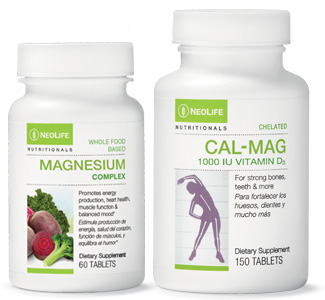 Your body systems consist of bones, organs, tissues, trillions of cells (both yours and microbial cells) and of course muscles—you name it! Each plays a unique role in how our body functions. Our muscles work in different ways and although it seems simple to raise your legs or flex your arms, the mechanics of these bodily processes can be complex and are heavily dependent on foods as an energy or fuel source and the quality of the nutrients that foods contain! Many minerals play a key role in regulating our bodily processes, such as the act of muscle contraction and relaxation. The major minerals of muscle contraction and relaxation are sodium, potassium, calcium, and magnesium.
Your body systems consist of bones, organs, tissues, trillions of cells (both yours and microbial cells) and of course muscles—you name it! Each plays a unique role in how our body functions. Our muscles work in different ways and although it seems simple to raise your legs or flex your arms, the mechanics of these bodily processes can be complex and are heavily dependent on foods as an energy or fuel source and the quality of the nutrients that foods contain! Many minerals play a key role in regulating our bodily processes, such as the act of muscle contraction and relaxation. The major minerals of muscle contraction and relaxation are sodium, potassium, calcium, and magnesium.
Magnesium is a mineral that plays a role in over 700 reactions within our body.1 Magnesium is essential from head to toe, being particularly important for energy production and for regulating the muscular, skeletal, and cardiovascular systems and immune and hormonal function.1 Our muscles are in fact very rich in magnesium—a massive 25 to 30% of total body magnesium is in the muscle (and around 50 to 60% is stored in the bone).1 With this in mind, think about the muscles in your body. There are skeletal muscles visible in your arms and legs as they are attached to bones, but there are two other muscle types—smooth muscle within internal organs, and then cardiac muscle is found within the walls of the heart.2 With over 600 muscles in the body,2 you can imagine the large role that magnesium has in our muscular system.
Fun Fact: Nearly 85% of our body heat is created by muscle contraction!2
Magnesium and its Role in Heart Health
The heart is a crucial organ for life and how the muscles in the heart function relating to contraction and relaxation can play a critical role in overall health. A simple heartbeat may sound like “lub dub” but in this case, this is simply the sound of your heart contracting and relaxing to pump blood. The process of pumping blood through the heart consists of different phases that all require the following minerals: sodium, potassium, calcium and magnesium.1 Magnesium’s specific role is to act as a conductor or traffic officer, and regulate the activity of the what comes in and out of the heart cells, as what comes in and out impacts the electrical signals of the heart.1 These electrical signals pass through the heart and allow the heart to contract and relax. Magnesium’s role with our body’s cellular energy currency, Adenosine TriPhosphate or ATP, is crucial for muscle contraction.1 Magnesium works to regulate the activity of calcium by controlling its release in cells, and it also indirectly affects sodium and potassium function.3 As mentioned before, all these different minerals play a role in muscle contraction, but it is important that their levels are controlled within the cell because too much or too little can create problems or imbalances which may lead to an array of problematic symptoms in the body, potentially worsening persistent low-level inflammation.5,6 Therefore, it is important to ensure the body has adequate levels of both calcium and magnesium.
When considering your personal dietary choices, it is of course important to have a balance of nutrients from foods. To ensure that you are consuming an adequate amount of magnesium, be sure to incorporate magnesium-rich foods such as dark green vegetables, legumes, cereals, fish and nuts in your daily diet.7 Though we need 310 to 420 mg per day for males and females, magnesium is generally an under-consumed nutrient for between 50 to 80% of Americans.7,8 In addition, magnesium is often poorly absorbed from food sources and along with unhealthy lifestyle factors and stress, many factors can impact your body’s magnesium levels.9,10 A magnesium supplement may therefore be useful in addressing these nutrient gaps.
NeoLife Magnesium Complex provides 300 mg of naturally-sourced and bioavailable magnesium—which features high-potency sources from an exclusive NeoLife Tri-Mag Blend, offering a double amino-acid chelated magnesium form known as magnesium bisglycinate as well as tri-magnesium citrate and magnesium oxide. In addition, Magnesium Complex includes a PhytoMag Blend making it the first magnesium supplement of its kind to feature whole food phytonutrients from beet, kale, radish, and broccoli. The benefits of magnesium include supporting energy production, balanced mood, strong bones and teeth, cardiovascular health, and muscular function.*
NeoLife’s long established product Chelated Cal-Mag also contains magnesium combined with calcium and vitamin D in ideal ratios to support bone health.* Cal-Mag minerals are also chelated with the amino acid glycine to enhance bioavailability according to the pioneering technology of Dr. Arthur Furst. Magnesium and vitamin D enhance digestion, absorption, and utilization of the calcium delivered.* Both Magnesium Complex and Cal-Mag may be taken together in your daily routine. Depending on your own personal needs, start with one tablet of Magnesium Complex daily, followed by a second tablet at a point most comfortable for you, as taking more magnesium than your body needs can sometimes have a laxative effect.*
 Written by:
Written by:
Natalie Masis, PhD, RDN | Research Manager
Dr. Masis is a registered dietitian nutritionist and earned her doctorate in Nutritional Sciences from the University of Illinois at Urbana-Champaign, a Master of Science in Nutritional Sciences from Texas Tech University, and both a Bachelor of Science in Nutritional Sciences and in Food Science from Cornell University.
References:
- de Baaij JHF, Hoenderop JGJ, Bindels RJM. Magnesium in man: implications for health and disease. Physiol Rev. 2015;95(1):1-46. doi:10.1152/physrev.00012.2014
- Muscles – National Library of Medicine. PubMed Health. https://www.ncbi.nlm.nih.gov/pubmedhealth/PMHT0022447/. Accessed August 2, 2018.
- Iseri LT, French JH. Magnesium: nature’s physiologic calcium blocker. Am Heart J. 1984;108(1):188-193. doi:10.1016/0002-8703(84)90572-6
- Rosanoff A, Dai Q, Shapses SA. Essential Nutrient Interactions: Does Low or Suboptimal Magnesium Status Interact with Vitamin D and/or Calcium Status? Adv Nutr. 2016;7(1):25-43. doi:10.3945/an.115.008631
- Mazur A, Maier JAM, Rock E, Gueux E, Nowacki W, Rayssiguier Y. Magnesium and the inflammatory response: Potential physiopathological implications. Archives of Biochemistry and Biophysics. 2007;458(1):48-56. doi:10.1016/j.abb.2006.03.031
- Office of Dietary Supplements. Magnesium. https://ods.od.nih.gov/factsheets/Magnesium-HealthProfessional/. Accessed May 30, 2018.
- Part D. Ch 1: Food and Nutrient Intakes, p. 2 – 2015 Advisory Report – health.gov. https://health.gov/dietaryguidelines/2015-scientific-report/06-chapter-1/d1-2.asp. Accessed May 1, 2018.
- Rosanoff A, Weaver CM, Rude RK. Suboptimal magnesium status in the United States: are the health consequences underestimated? Nutr Rev. 2012;70(3):153-164. doi:10.1111/j.1753-4887.2011.00465.x
- MedlinePlus Medical Encyclopedia. Low magnesium level. https://medlineplus.gov/ency/article/000315.htm. Accessed May 17, 2018.
| Savings Made Simple Join our Club Member program – It’s free, simple and gives valued customers the ability to shop at a special 15-30% discount, as well as access to nutritional education, free product when you refer friends, weight loss and fitness challenges, and fun events around the country. |
Nutrition Startups NeoLife is redefining the world of startups, helping entrepreneurs around the world unlock a better way of life. We offer a solution to life’s most pressing needs and wants, no matter what stage you’re at. As a Promoter you experience the same Club Member benefits PLUS particiapte in all the benefits of our Compensation Plan, exciting incentives like cash and travel and recognition for your achievements.
|
Learn more at NeoLife.com or by calling NeoLife Sales Support at 800.432.5842.
